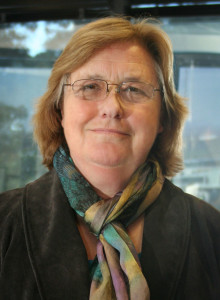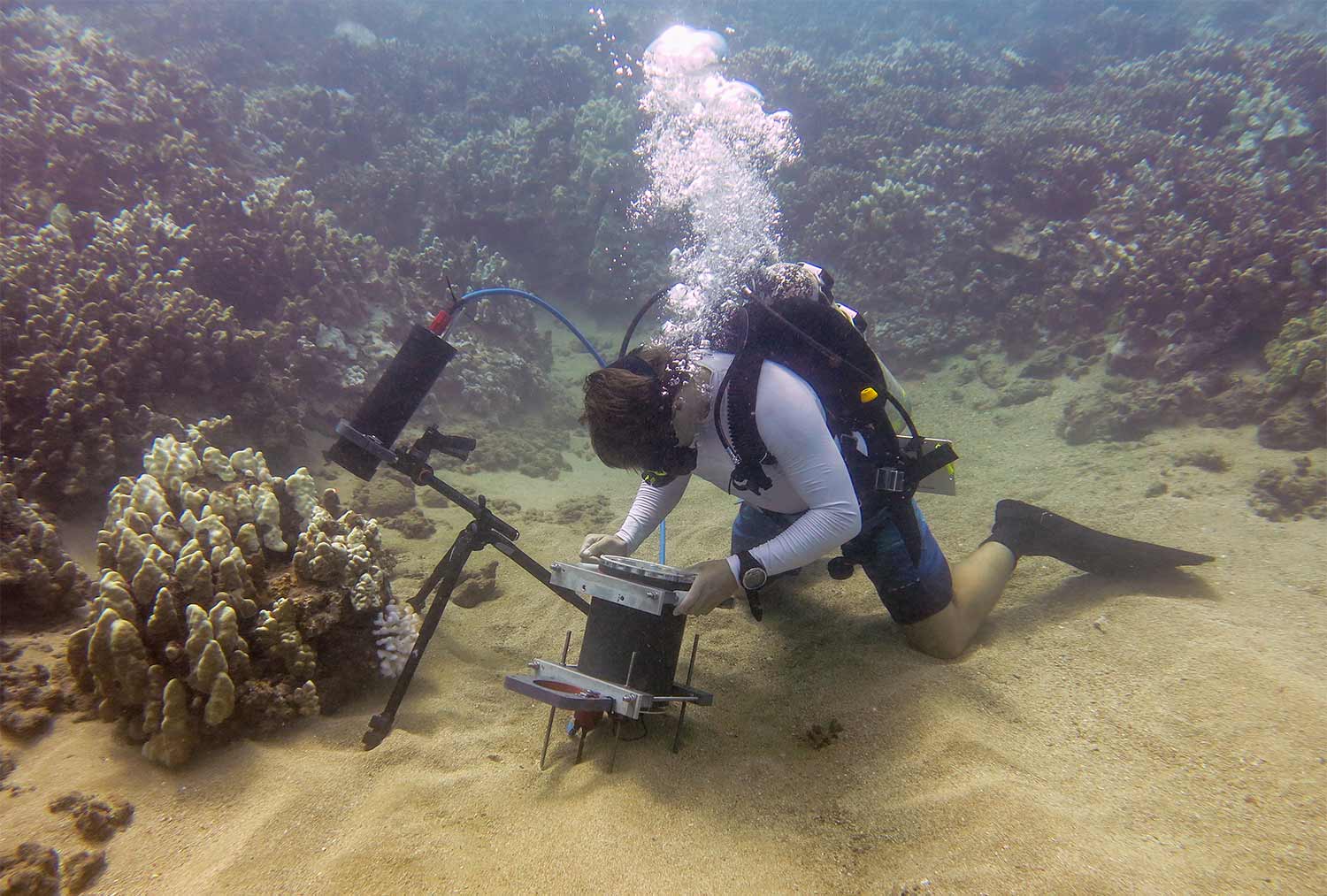Daily Business Report-July 22, 2016
Scripps Oceanography graduate student Andrew Mullen positions the Benthic Underwater Microscope to study coral competition. (Credit: Jaffe Laboratory for Underwater Imaging/Scripps Institution of Oceanography, UC San Diego)
Scripps Researchers Develop Novel
Microscope to Study Underwater World
By Anne Reisewitz, UC San Diego News Center
A new microscopic imaging system is revealing a never-before-seen view of the underwater world. Researchers from Scripps Institution of Oceanography at the University of California San Diego have designed and built a diver-operated underwater microscope to study millimeter-scale processes as they naturally occur on the seafloor.
The research team observed coral turf wars, coral polyp “kissing,” and much more using the new microscopic technology.
Many important biological processes in the ocean take place at microscopic scales, but when scientists remove organisms from their native habitats to study them in the lab, much of the information and its context are lost. In a quest to overcome this challenge, Scripps oceanographer Jules Jaffe and his team have developed a new type of underwater microscope to image marine microorganisms in their natural settings without disturbing them.
The Benthic Underwater Microscope, or BUM, is a two-part system–an underwater computer with a diver interface tethered to a microscopic imaging unit–to study marine subjects at nearly micron resolution. The instrument has a high magnification lens, a ring of focused LED lights for fast exposures, fluorescence imaging capabilities, and a flexible tunable lens, similar to the human eye, to change focus for viewing structures in 3-D.
“This underwater microscope is the first instrument to image the seafloor at such small scales,” said Andrew Mullen, a Ph.D. student at Scripps and the Jacobs School of Engineering and co-lead author of the study published in the July 12 issue of the journal Nature Communications. “The system is capable of seeing features as small as single cells underwater.”
The motivation for building the imaging system was to better understand the many ecological processes taking place underwater on a microscopic scale, according to the Scripps researchers.
“To understand the evolution of the dynamic processes taking place in the ocean, we need to observe them at the appropriate scale,” said Jaffe, the senior author of the study, and head of the Jaffe Laboratory for Underwater Imaging at Scripps.
To test the new technology’s ability to capture small-scale processes taking place underwater, the researchers used the imaging system to view millimeter-sized coral polyps off the coast of Israel in the Red Sea, and off Maui, Hawaii.
_____________________________________________
TSRI Scientists Receive Funds to Advance
Stem Cell-Based Parkinson’s Therapy
Scientists at The Scripps Research Institute and Scripps Clinic have received a grant of nearly $2.4 million from the California Institute for Regenerative Medicine to support safety and quality tests of a potential stem cell therapy for Parkinson’s disease.

The new two-year project will be led by Jeanne Loring, professor of developmental neurobiology at TSRI. Loring will be partnering with Melissa Houser, M.D., neurologist and medical director of the Parkinson’s Disease and Movement Disorders Center at Scripps Clinic.
“The goal is to restore the quality of life for Parkinson’s patients,” said Loring. “The methods we’re using will raise the bar for quality considerably—for all kinds of cell therapy.”
“What sets our study apart from many others is that it’s patient-specific,” said Houser. “Our hope is that this grant will help to begin a new era of long-term treatment for Parkinson’s disease.”
Parkinson’s disease strikes when specialized neurons in the brain begin dying. These neurons produce dopamine, a chemical messenger that maintains normal nerve-firing patterns. Without dopamine, patients suffer from tremors, a lack of balance and even speech difficulties.
For the study, the Loring lab will investigate induced pluripotent stem cells (iPSCs), which are derived from adult subjects and can differentiate into any kind of cell in the body. In this case, iPSCs derived from cells donated by 10 Scripps Clinic Parkinson’s patients were developed into dopamine-producing neurons — the same kind that die during Parkinson’s. The new grant will allow the researchers to advance these cells through U.S. Food and Drug Administration preclinical testing requirements, with the hope of moving closer to clinical trials.
Loring’s work focuses in part on improving the quality and safety of stem cell therapies. She and her colleagues recently published the first comprehensive analysis of genomic sequence of iPSCs, and her lab’s advances include the development of the PluriTest quality control assay for pluripotency (the ability of stem cells to differentiate), which was recently licensed to The Coriell Institute for Medical Research.
Delays Continue as Southwest
Grapples with Computer Glitch
By City News Service
Air travelers endured extensive delays at Lindbergh Field for a second day Thursday as Southwest Airlines continued to recover from a massive computer glitch that temporarily halted all its flights.
Three of the airline’s arrivals scheduled at San Diego International Airport over the day were canceled, as were four departures, officials reported. A total of 21 arrivals were postponed, along with the same number of departures.
Southwest “began experiencing intermittent performance issues” Wednesday afternoon, which prompted a temporary halt to all flights that had not yet left the gate, according to the airline. The ground stop was lifted around 1 p.m., but delays continued.
More than 220 flights nationwide were canceled because of the mishap, according to Southwest spokeswoman Linda Rutherford.
“I want to start off by once again apologizing to our customers and reiterating that your experience throughout the past 24 hours is not the service you should expect from Southwest Airlines,” Rutherford said. “Most of our systems are back online this morning following yesterday’s technology outages, but recovery will take some time.”
Additional cancellations and delays are possible as the airline positioned its aircraft and crews, Rutherford said.
Airport officials thanked travelers for their patience and urged them to check the status of their flights before heading to Lindbergh Field.
“Thank you for hanging in there with us,” Rutherford said. “We will have more information later regarding flexible rebooking, and we will continue to work with each and every affected customer to make this right.”
Alaska Airlines Adding Daily
Nonstop Service to Newark
Times of San Diego
Alaska Airlines is planning new nonstop service between San Diego and Newark, the busiest airport in the New York area and a growing hub for international flights.
The San Diego County Regional Airport Authority confirmed Thursday the new service will operate daily beginning Nov. 21 on Boeing 737 aircraft. Tickets for the new route will go on sale July 25.
Flights will leave San Diego at 9:55 a.m. and arrive at 5:55 p.m. Return flights will leave Newark at 7 p.m. and arrive at 10 p.m.
“We are pleased Alaska Airlines continues its network expansion in San Diego by adding flights to the New York/Newark metropolitan area,” said Hampton Brown, the San Diego airport’s director of air-service development. “With Newark’s efficient public transport links, travelers will be able to fly from Downtown San Diego and reach the center of Manhattan in about six hours.”
Alaska Airlines thanked the Federal Aviation Administration and the Port Authority of New York and New Jersey for their “efforts to increase competition in the New York metro area.”
“Since 2015, Alaska has launched 28 new routes from our West Coast hubs and focus cities,” said John Kirby, Alaska Airlines’ vice president of capacity planning. With our new expanded service to Newark, we continue to grow our West Coast footprint by offering our valued customers more nonstop flights to popular business and leisure destinations.”
The new San Diego–Newark service is Alaska Airlines’ third East Coast destination from San Diego.


